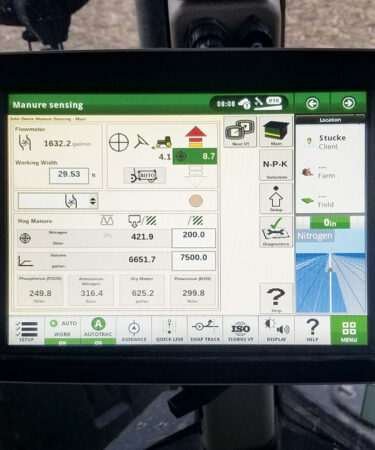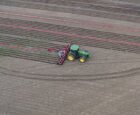It’s called farmer’s gold for a reason. Long before liquid manure’s value was generally understood in terms of scientific benefits, farmers were applying it to fields to improve crop yields and vigor. The gold came from better results, and therefore more cash in pockets, at the end of the season and in seasons to come.
Although the practice of spreading liquid manure on crop fields is fairly simple and well-accepted, it is also deeply rooted in scientific principles that early agriculturalists didn’t know. This isn’t to say there’s a need to slip on an Einstein wig to get manure applications to optimal levels, but the wild-haired genius’s work in how light interacts with matter was a contributor to the development of liquid manure sensors. These sensors work with the inherent variability in liquid manure nutrient levels to help farmers achieve ideal application rates on any field.
At Ohio State University, John Fulton, a professor in the department of food, agricultural and biological engineering is helping farmers understand how liquid manure sensors optimize manure’s wealth of nutrients and bring greater robustness to crops without over-application.
“Farmers will know what nutrients are going into the field, as they go out into the field,” Fulton says of how liquid manure sensors benefit farms in on-demand settings.
Liquid manure sensors are mounted on the flow pipe after a hole has been cut in the pipe. As the manure flows across the sensor, it identifies the constituents in the manure and operators receive the information they need about nutrients being applied in the moment. This data allows for immediate changes in terms of manure application speed and rate to fit the field’s requirements.
In science, and in farming, more precise data drives better decisions
“There’s a flow meter on the inline that measures the gallons per minute or the gallons per hour,” he says. “Knowing the flow in the sensor, I can estimate the pounds per acre of each constituent that’s being applied.”
Adding a liquid manure sensor to manure spreading practices is a matter of precision. Understanding the N, P and K values of the soil, as well as those in the manure being spread, to achieve nutrient levels that fit the crop is the holy grail for most farmers; almost the equivalent to how Einstein must have felt when he discovered the theory of relativity.
The manure sensor’s near-infrared (NIR) sensing estimates factors such as nitrogen, phosphorus, potassium, ammonia and other substances in the manure. Each material has its own band or region within the electromagnetic spectrum and by shining the NIR light on the manure, the reflectance determines which band (and therefore which nutrient) is present, and in which quantities, at any given time.
Currently, liquid manure sensors are able to measure nitrogen, potassium, phosphorus, ammonia, and dry matter.
“It does a really good job of detecting the dry matter or solids in that manure,” Fulton says. “The near-infrared looks at the percent reflected energy of those bands as it changes. It indicates the constituent of that manure.”
Why not just take a sample?
Soil sampling is the benchmark before nutrient application. Having that baseline gives a farmer their starting point. The levels of nutrients required for a successful crop come from understanding what is in place prior to application.
So, why not just take a sample of the manure as well? After all, one plus one equals two. But as Fulton explains, one isn’t always equal to one.
“Normally, we go out and take soil samples in the field in order to understand what the soil fertility levels are. Then we’ll take a sample in the [manure] pit to know. Then I can calculate how much of that liquid manure I can put on the field, [considering] whatever the recommendations or limits are for that [region],” he says. “As I draw down the lagoon, it stays fairly even, but all of a sudden, it can jump up. If all of a sudden the concentration jumps up, I could overapply in that field.”
The majority of liquid manure sensors are being used on the pipes to take advantage of the ability to change the rate of application. However, there are options for more static measures.
“Most of the people are using it out in the field. That’s where companies are selling them,” Fulton says. “That’s what most people are thinking about when they talk about liquid manure sensors. Now, there are also kind of desktop versions where you can just take a sample at a point out of the pit and measure that as well.”
Although this “snapshot in time” approach has value, the real benefit lies in seeing what the level of nutrients are in “real time,” he says. “As a farm operator, if I see those rates change, maybe I need to make an adjustment.”
This can include changing the rate of flow on the pump or changing the speed of the tractor.
“Basically, I’m reducing the rate at which I’m applying,” he says. “If it starts high and then starts to drop, I might be able to slow down or adjust the pump speed.”
Adapting to a new technology
Fulton notes that John Deere, CNH Industrial and Zunhammer all have liquid manure sensors field ready, but he cautions there are considerations before pulling out the checkbook. The first, and perhaps most important, is to ensure the technology will work with existing farm equipment.

computer interface pictured here.
“Most of the sensors are only going to work with newer technologies,” Fulton says. “Farmers have to be up-to-date on more modern or newer displays on the tractors. They’ve got to have the integrated screens and then it has to be one of the more recent versions with capabilities built into it.”
Checking compatibility or upgrade options beforehand will make the difference between money wisely spent to make more money and a costly path of purchases and modifications to make existing tools adapt. Calibration is another consideration. Fulton says most of the sensors have some calibrations built into the systems, but be prepared for a time investment to collect samples, run lab tests, compare and adjust. Each farm is unique and so is the manure it uses.
“They have to be calibrated for the various types of manure that are out there,” he says. “You could have dairy, you could have beef, you could have swine. Some farmers even mix those. Nutrition fed to the animals influence those calibrations. In Europe, they’ve done a really good job of calibrating. But even so, they’re not absolute. But it gives you a close estimate and tells you when things significantly change.”
Mounting the sensor itself doesn’t require much in the way of modification. Retrofitting to existing pipes is easy with only a hole and mounting of the sensor required. “As long as it’s liquid manure, I would assume either the farmer, or the custom applicator, they would have the right equipment,” he says. “Most of your tankers… they can be retrofitted. Or a drag line.”
Farming is science
The benefits of using a liquid manure sensor during application are numerous with scientific data topping the list.
“Number one, it gives that feedback to understand as you’re pumping down a pit, what the relative concentration of nutrients is in the manure,” Fulton says. With this comes the ability to make changes to the rate of application on the fly.
“Because of that, we’re being better stewards of the environment because we’re eliminating conditions where we’ve had run-off or excess levels of nitrogen or phosphorus,” he says.
Plus, with each application comes a long-term record of application that shows how much of each nutrient was applied where. This data also informs future decisions in terms of field management for future applications.
Simpler methods of applying science to agriculture can improve the transformation of manure into farmer’s gold. •















